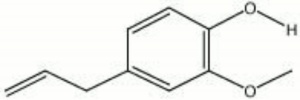Difference between revisions of "Eugenol"
Jump to navigation
Jump to search
(username removed) |
m (Text replace - "== Authority ==" to "== Sources Checked for Data in Record ==") |
||
| Line 40: | Line 40: | ||
Fisher Scientific: [https://fscimage.fishersci.com/msds/03672.htm MSDS] | Fisher Scientific: [https://fscimage.fishersci.com/msds/03672.htm MSDS] | ||
| − | == | + | == Sources Checked for Data in Record == |
* G.S.Brady, ''Materials Handbook'', McGraw-Hill Book Co., New York, 1971 Comment: p. 201 | * G.S.Brady, ''Materials Handbook'', McGraw-Hill Book Co., New York, 1971 Comment: p. 201 | ||
Revision as of 20:21, 30 April 2016
Description
A colorless, essential oil that smells like cloves. Eugenol is extracted from clove oil obtained from the evergreen tree Caryophillus aromaticus. It is currently used in perfumes, flavorings, and as an antiseptic in medicine. Eugenol has been used as a preservative for proteinaceous media and adhesives. One other application is as an insect attractant.
Synonyms and Related Terms
clove oil; 4-allyl-2-methoxyphenol; caryophyllic acid; eugenic acid; 2-methoxy-4-(2-propenyl)phenyl; allylguiacol
Other Properties
Miscible with ethanol, chloroform, ether, oils. Slightly soluble in water.
| Composition | C10H12O2 |
|---|---|
| CAS | 97-53-0 |
| Melting Point | -9.1 |
| Density | 1.0664 |
| Molecular Weight | mol. wt.=164.2 |
| Boiling Point | 225 |
Hazards and Safety
Combustible. Flash point = 104 C (219 F)
Fisher Scientific: MSDS
Sources Checked for Data in Record
- G.S.Brady, Materials Handbook, McGraw-Hill Book Co., New York, 1971 Comment: p. 201
- Richard S. Lewis, Hawley's Condensed Chemical Dictionary, Van Nostrand Reinhold, New York, 10th ed., 1993
- Random House, Webster's Encyclopedic Unabridged Dictionary of the English Language, Grammercy Book, New York, 1997
- The Merck Index, Martha Windholz (ed.), Merck Research Labs, Rahway NJ, 10th edition, 1983 Comment: entry 3944
- The American Heritage Dictionary or Encarta, via Microsoft Bookshelf 98, Microsoft Corp., 1998
